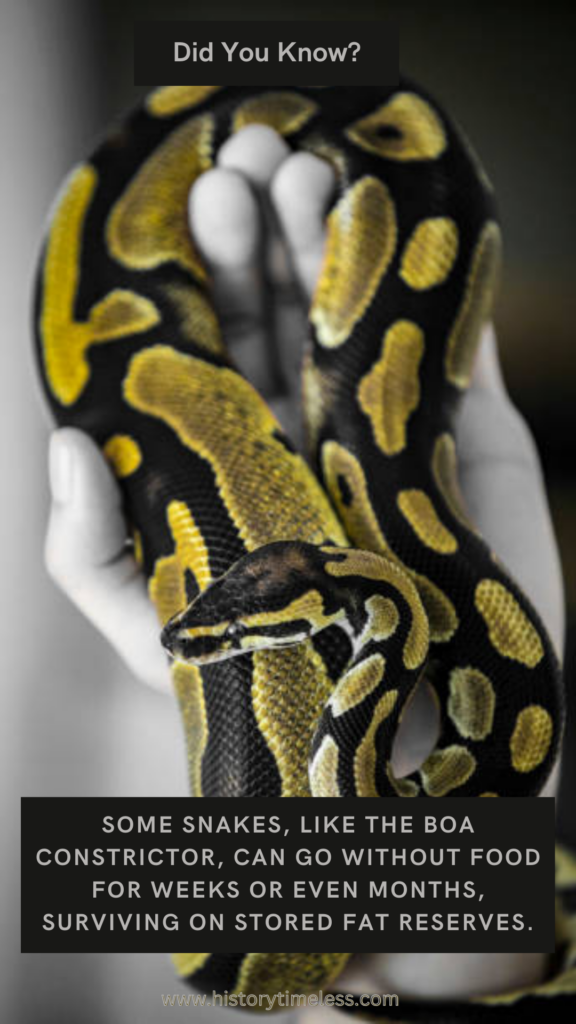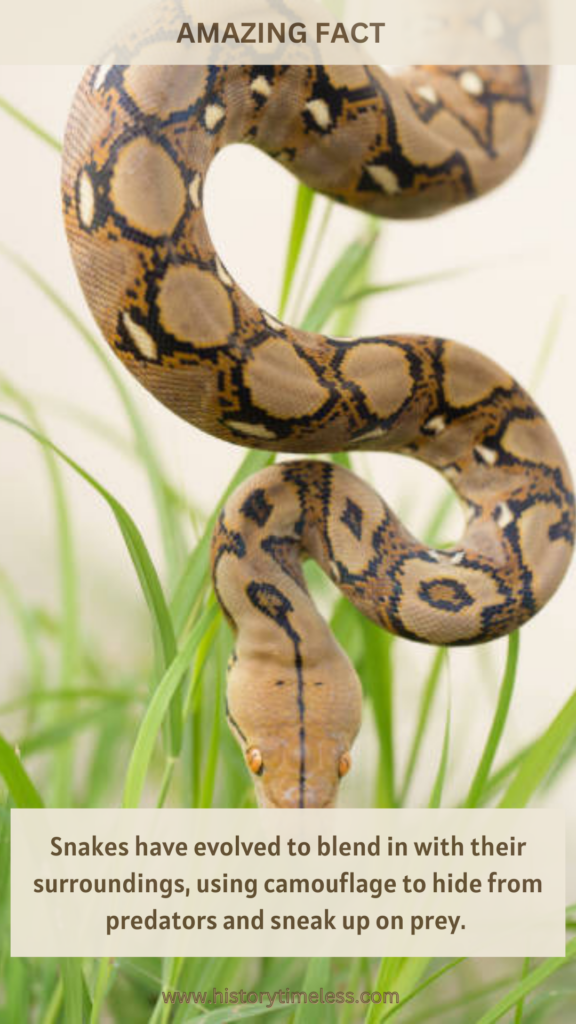Snakes are fascinating creatures that have been on our planet for over 100 million years. With over 3,000 species, they can be found on every continent except Antarctica. From venomous species to massive constrictors, snakes are incredibly diverse. Here are 26 crazy snake facts that’ll leave you speechless, showcasing their unique characteristics, abilities, and behaviors.
1. Snake’s Importance in Ecosystems
Snakes play a vital role in maintaining the balance of ecosystems, preying on rodents and other small animals that can damage crops and spread disease. They are an important part of the food chain, and their loss could have significant consequences for the environment.
2. Rattlesnake’s Rattling Sound
Rattlesnakes have a unique rattle on their tails that they use to warn potential predators of their presence. The rattle is made up of loose, dangling scales that vibrate to produce a distinctive sound.
3. Copperhead’s Aggressive Behavior
Copperheads are known for their aggressive behavior when threatened, and will often bite humans in self-defense. They are venomous, but their venom is relatively mild, and most bites are not life-threatening.
4. Snake’s Ability to Go Without Food

Some snakes, like the boa constrictor, can go without food for weeks or even months, surviving on stored fat reserves. This is made possible by their slow metabolism and efficient digestive system.
5. Krait’s Nocturnal Behavior
Kraits are nocturnal snakes that are most active at night, using their acute sense of smell and exceptional night vision to hunt for prey. They are highly venomous and can deliver a deadly bite to unsuspecting humans.
6. Snake Skin Shedding
Snakes shed their skin periodically as they grow, a process called ecdysis. During this process, the snake’s skin is completely replaced, including the scales, which are made of keratin, the same protein that makes up human hair and nails.
7. Ball Python’s Docile Nature
Ball pythons are known for their docile nature and are often kept as pets. They are non-venomous, gentle, and can live for up to 30 years in captivity, making them a popular choice for snake enthusiasts.
8. Anaconda’s Massive Size
The green anaconda is one of the largest snakes in the world, with some individuals reaching lengths of over 30 feet and weighing over 500 pounds. Despite their massive size, anacondas are expert hunters and can go weeks without eating.
9. Snake’s Super-Sensitive Smell
Snakes have a highly developed sense of smell that is up to 10,000 times more sensitive than that of humans. They use their forked tongues to collect chemical cues from their environment, which are then analyzed by the Jacobson’s organ in the roof of their mouth.
10. Inland Taipan’s Deadly Venom
The inland taipan is considered the world’s most venomous snake, with a single bite capable of killing a human being within 45 minutes. Its venom is a powerful neurotoxin that can cause respiratory failure and cardiac arrest.
11. Boa Constrictor’s Squeezing Power
Boa constrictors are skilled hunters that can squeeze their prey to death using their powerful coils. They can exert a pressure of up to 300 pounds per square inch, making them one of the most formidable predators in the animal kingdom.
12. Snake’s Regenerative Abilities
Some snakes, like the garter snake, have the ability to regrow lost body parts, including their tails. This is made possible by the presence of stem cells throughout their bodies, which can differentiate into different types of tissue.
13. Taipan’s Speed
The taipan is one of the fastest snakes in the world, with some species able to move at speeds of up to 18 miles per hour. They are agile and highly venomous, making them a formidable predator in their natural habitat.
14. Snake’s Electroreception
Some snakes, like the pit viper, have specialized electroreceptors called ampullae of Lorenzini that allow them to detect the electromagnetic fields generated by all living creatures. This helps them to navigate and locate prey in complete darkness.
15. Snake’s Camouflage Abilities
Snakes have evolved to blend in with their surroundings, using camouflage to hide from predators and sneak up on prey.

Some species, like the leaf-nosed snake, have elaborate camouflage patterns that make them almost invisible.
16. Coral Snake’s Deadly Pattern
The coral snake’s pattern of red, yellow, and black bands is a warning signal to potential predators that it is venomous. The snake’s venom is a powerful neurotoxin that can cause respiratory failure and cardiac arrest.
17. Sidewinding Snake Movement
Some snakes, like the sidewinder, have evolved to move in a unique, wave-like motion, allowing them to navigate through sandy or rocky terrain with ease. This movement is made possible by the snake’s specialized scales and muscles.
18. Snake’s Hibernation Patterns
Some snakes, like the gopher snake, hibernate during the winter months to conserve energy and survive the cold. During hibernation, their metabolism slows down, and they can survive for months without eating or drinking.
19. Snake’s Social Behavior
Some snakes, like the garter snake, are highly social creatures that live in large groups. They have a complex communication system that involves chemical cues and body language, and will often gather in large numbers to mate or bask in the sun.
20. Cobra’s Hood Expansion
When threatened, cobras can expand their neck skin to form a hood, making them appear larger and more intimidating. This hood is made of skin and muscle, and is often accompanied by a hissing sound.
21. Snake’s Heat-Sensing Pits
Some snakes, like pit vipers, have heat-sensing pits that allow them to detect the body heat of warm-blooded prey. These pits are highly sensitive and can detect temperature differences of as little as 0.001°C.
22. Snake Species Diversity
There are over 3,000 known species of snakes, ranging from the tiny 4-inch-long threadsnake to the massive 30-foot-long green anaconda. Each species has its unique characteristics, such as venom, patterns, and habitats.
23. Python’s Stealthy Hunting
Pythons are stealthy hunters that can ambush their prey using their camouflage and powerful coils. They can remain motionless for hours, waiting for the perfect moment to strike, and can even go without eating for weeks or months.
24. Snake’s Adaptation to High Altitudes
Some snakes, like the Himalayan pit viper, have adapted to high-altitude environments, where the air is thin and the temperatures are cold. They have specialized physiological adaptations that allow them to survive in these extreme conditions.
25. Water Snake’s Water Resistance
Some snakes, like the water snake, are highly resistant to water and can stay submerged for up to an hour. They have a specialized skin that prevents water from penetrating to their scales, and can even drink salt water without getting sick.
26. Venomous Snake Evolution
Venomous snakes have evolved to produce complex venom that can immobilize their prey. The evolution of venom is believed to have occurred independently in different snake lineages, resulting in a wide range of venom types and potencies.
Find Out More Enthralling Tidbits:
25 Mind-Blowing Facts About Your Brain You Need to Know
30 WWII Facts That Will Change How You See History
26 Insane Facts That Will Leave You Speechless





